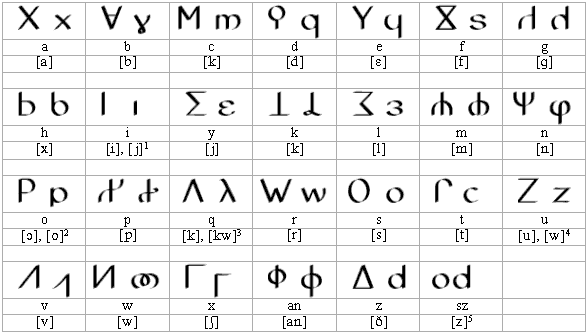Viozian language and alphabet 
The Viozian language and alphabet were created by Dirk Bakker
from Groningen in the Netherlands when he was about ten years
old (in 1989). Already fond of secret codes and nice scripts,
he fantasized about devising a language of his own that nobody
could understand.
For the words he started with making a letter-based code in
which the letters of the Dutch alphabet were mixed up in random
order: a=u; b=x; c=y etc. He did this in such a way that the
vowels remained vowels, in order to avoid unpronouncability.
Thus for instance the word ‘water’ (which is ‘water’ in Dutch)
became ‘cumok’ (w=c; a=u; t=m; e=o; r=k). Next he created the
letters, based somewhat on Latin and Greek. Over the years the
words became less and less Dutch-like as he created suffixes,
cases, pronunciation rules etc. By now a vast and complex grammar
has evolved, and the language is still growing and changing today.
A language cannot be fully mature without a people who speak
it and a culture by which it is used, so Dirk made up the island
of Viozia (‘Good Island’). He placed it about 200 miles off the
Brazilian coast (later he discovered that there happens to be a
real island on the very spot, called Fernando de Noronha) and
inhabited it with a primitive but intelligent people who are
a mixture of native South Americans and West Africans.
The alphabet script as described below replaced their older
logographic script, and has evolved into a number of different
styles. The one which is given here is the most common variety
nowadays and had the most similarities with Western script (e.g.
in the use of capitals and small letters).
Finally Dirk made an computer font for the Viozian language,
so now, after almost 16 years, it is possible to share it with
all those other language creators around the globe. He hopes
they will like it!
Notable features
- The script is written from left to right in horizontal lines.
Viozian alphabet

Elongated vowels

Punctuation

Notes
- [j] in diphtongs; [i] elsewhere.
- [ɔ] in closed syllables; [o] in open syllables.
- [kw] preceding a vowel; [k] elsewhere.
- [w] in diphtongs; [u] elsewhere.
- Also when the s and z are parts of two different words:
‘os zo’ (‘and the’) is pronounced [ɔzo] not [ɔs ðo]. - Also when the s and z are parts of two different words:
‘os zo’ (‘and the’) is pronounced [ɔzo] not [ɔs ðo].
Sample text in Viozian
![]()
Latin transliteration
Uqu rose voxukos bakan oi qanp me ook oi koyme. Wom vovoto
ga lsuh oi yoazbug os gan wakos ziotos ui ui me zoosp bua gelmo.
IPA transliteration
/’ukwu ‘rɔsɛ vo’ʃukɔs ba’kan oj
kwanp mɛ o:k oj ‘kojmɛ. wom vo’voto ga l’su:x
oj ‘joaðbu:g ɔs gan ‘wakɔs ‘ðjɔtɔs
uj uj mɛ ðo:sp bwa ‘gɛlmo/
Translation
All human beings are born free and equal in dignity and rights. They are endowed with reason
and conscience and should act towards one another in a spirit of brotherhood.
(Article 1 of the Universal Declaration of Human Rights)
